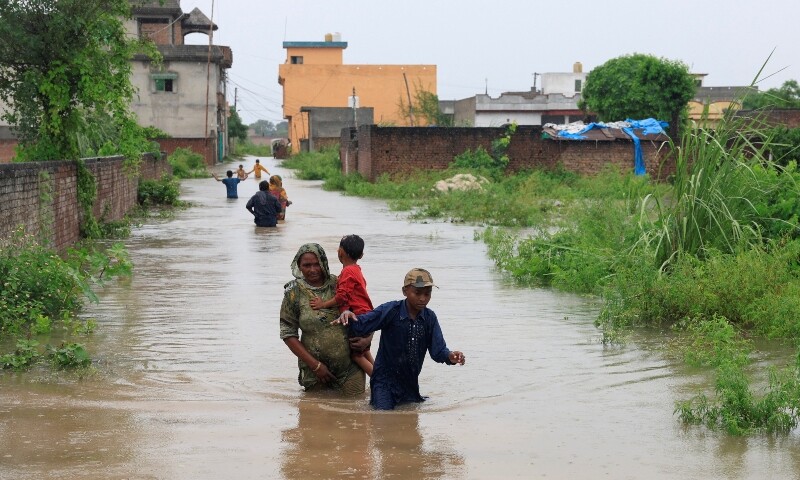THE poet Robert Frost believed that good fences make good neighbours. But for the residents of Kotli Loharan, a peri-urban community located on the outskirts of Sialkot, it is the lack of drainage — not fences — which has neighbours virtually at each other’s throats.
The town’s western side, through which the Khannay Wala Nullah flows, is slightly more elevated than the eastern side. The area has always been prone to flooding whenever the river overflows, but in the past, the water would find its course through the alleyways of the community in the form of rivulets and end up in the seasonal drain.
This time around, however, the sheer amount of water is staggering to behold, and it has not been able to find its natural path to drain into the nullah.
Make no mistake, both the eastern and western ends of Kotli Loharan are submerged; but while the water level to the east is around 6 feet, the west side is under half that depth.
Residents on one side want culverts dismantled so floodwater can drain into the nullah, a proposal that has faced stiff opposition from those that dwell near the seasonal drain
Over the past five to six days, residents of the eastern side have struggled to dismantle culverts in a bid to divert the water west, so it can flow into the Khannay Wala Nullah.
This plan has faced stiff resistance from those who dwell on the other side, who have blocked efforts by locals and the district administration to make any cuts that would add to their watery woes.
This post-flood situation has created internal rifts, differences and given birth to water politics in the area — which is already reeling from outbreaks of disease brought on by the deep, stagnant waters – and curtailing cooperation with the government to deal with such situations.
“We have been cut off from Sialkot since Aug 26, as floodwaters are still present in our area, inside our homes,” says Zafar Abbas Bukhari, a resident of the eastern side. “Many of our children and elderly people are ill and getting medicines from relief camps and other sources. But the issue is yet to be resolved,” he tells us.
Another youth, Inam, narrates how he would ride into town on a tractor trolley to buy groceries, and then make the perilous journey back, just so his family could eat.
Mr Bukhari says officials had brought excavators to break down the culverts to allow the water to drain out the other side. But people from western side of Kotli Loharan had the work forcefully halted, arguing that their homes would be submerged under yet more water if this were to happen.
According to Deputy Commissioner Saba Asghar Ali, the issue in Kotli Loharan stems from the subdivision of agricultural land and the development on residential zones on it.
It has become common practice; first, structures are built illegally, then residents start demanding the construction of roads, sewage and other infrastructure, she deplored.

Massive flows
On Aug 26, a flood of around 400,000 cusecs hit Head Marala — near Sialkot — during the night. The flow increased rapidly to 917,525 cusecs, causing widespread flooding.
Although relief camps were reportedly made operational, many residents did not hear the announcements and remained in bed, leading to 22 fatalities in Sialkot city and Sambrial tehsil.
The devastating collapse of the Hanji bridge at Nullah Dek only compounded the area’s problems.
Official data indicates that Sialkot tehsil was impacted by the overflowing of both nullahs, Dek and Palkhu, as they exceeded safe limits.
The damage so far include two collapse bridges, 46 culverts, 36 roads and 340,240 acres of cropland affected.
Unfortunately, Sialkot city and its suburbs still lack a modern drainage system, with domestic waste and storm water being pumped and disposed through the same sewage lines, laid decades ago.
The government also started a plan, implemented under the Punjab Intermediate Cities Improvement Investment Programme, with support from the Asian Development Bank some years ago, but it is yet to become operational due to various pending engineering issues, including the desilting of nullahs.
Published in Dawn, September 2nd, 2025

